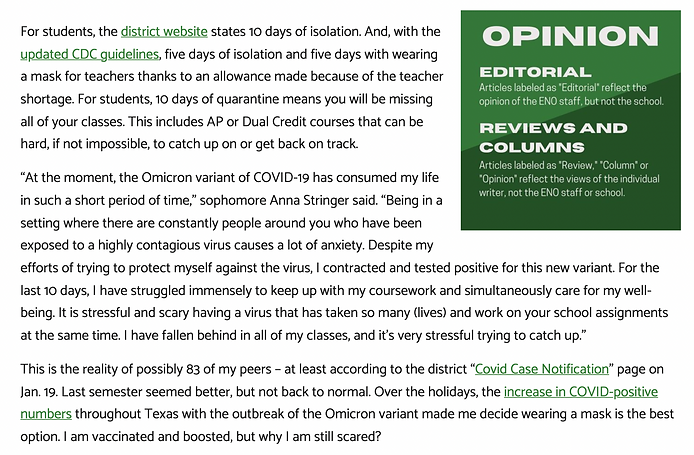LAW, ETHICS AND NEWS LITERACY
Understanding and upholding news law and ethics is essential to staying a quality, trustworthy paper. As a paper, we ensure that we're doing this in many ways. As an editor, I work to make sure our staff members are aware of these laws and ethics by teaching them our rules and guidelines that we follow to stay trustworthy.
FACT CHECKING AS WE EDIT
We first require three sources in every article to prevent one-sidedness in our stories. Whenever we edit news stories we always check for opinionated words in our stories as well. If we are unsure about information in an article, we always check it. For example, one of our reporters wrote an article on the student ranked number one in the senior class, and to do a quick confirmation, we emailed an assistant principal to confirm that he wasn't lying about his class rank (she of course couldn't reveal that type of information, however, she did assure us that we could trust him).
RECORDING INTERVIEWS
We record every interview to not only get exact quotes, but to also hold them as a record in case any problems arise in the future. If the interview is recorded at our podcast table with good audio quality, then we will post the audio on all of our audio platforms for even more transparency. For example, I interviewed the district lawyer for a feature article and we posted the recording of our interview.
OPINION SECTION CLARITY
This year, we started to get more and more comments on our opinion articles where someone would be annoyed that we were "presenting our opinion as fact." So, the opinion editor and I decided to add a note on our site defining the types of opinion articles and how they don't represent the views of the staff and the school. I also made a graphic that we can add into articles in order to make the definition of an opinion article as clear as possible.



Here's an example of the graphic in an article.

NEW VOICES
I wanted the staff to be aware of the opportunities they had in the legislation side of student journalism, so I reached out to our regional representative of the New Voices movement, Kate Knauff, and asked her to give our staff a presentation about the movement. She did it over a Zoom call, and the meeting went very well. We got some great information and links that we can use in the future.
Click on the photo below on the left to see our email thread setting up the meeting.




STAYING UNBIASED AND FAIR
Keeping our news stories unbiased is, of course, essential in our paper. Whenever we're publishing stories that could have multiple sides, I'm always careful to edit for those biases, and the biggest problem my staff has with this is just using specific words with either negative or positive connotations. I always make a point to show them the words and make sure they change them.
Another thing I'm careful about is covering every side. When there are multiple sides to a news story, we must cover and give a voice to all of them, no matter personal biases or views. For example, I covered a very controversial local school board meeting one month. The meeting had about 50 community speakers, but of course, I couldn't include all of them. I was careful to try to include an equal number of quotes from each side to ensure that I stayed neutral.
We also had some students wanting to cover the state abortion laws as they've recently changed and grown more controversial. One staff member wanted to write an opinion article on it, so we made sure another student wrote an opinion for the other side. I also created an unbiased timeline to go with them and create a whole multimedia package (which I mention more in the web and social media section). Covering both sides kept us unbiased as a whole paper while representing a popular topic in our community.


QUOTE 1:
Against masks

QUOTE 2:
Against masks
QUOTE 3:
Defending masks
This part didn't flow well in the article, but it was still important to cover, so I put it in a sidebar.
QUOTE 4:
Virtual learning
Here's a news article I've published, and how I represented multiple sides equally in the article:
COPYRIGHT
Besides doing the obvious of following copyright laws, we also prohibit any images that are taken completely from the Internet even if we have the right to reuse them. For example, if we're publishing an album review, we don't use just the album cover as a featured image, we have to make a graphic (but we can use the album cover in that graphic).
Here's a screenshot of our entertainment page, where you can see how we use album covers, movie posters or book covers to create a digitally constructed featured image. This ensures that the majority of the work on our page is our own.
